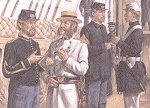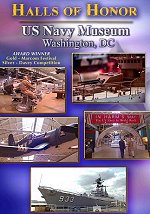USS Brooklyn
The first Brooklyn was the first of five screw sloops of war authorized by Congress on 3 March 1857; laid down later that year by the firm of Jacob A. Westervelt and Son; launched in 1858; and commissioned on 26 January 1859, Capt. David G. Farragut in command.
On 5 February, Brooklyn got underway for a trial run to Beaufort, S.C., where she arrived on the 11th. Following a week's visit to that port, she headed for the West Indies to investigate conditions in Haiti where liberal forces had ousted Emperor Saluke and installed Geffrard as President. Farragut found that the people of Haiti were delighted to be free of the oppressive rule of the former monarch and with the end of a racial war that had bled their nation. Upon the recommendation of the American consul, Farragut sailed for the Isthmus of Panama.
After visiting Aspinwall, Brooklyn set a course for the Mexican coast and reached Veracruz early in April. The legal president of Mexico, Benito Juarez--who had been driven from Mexico City by forces of General Miramon of the Clerical Party--was making that seaport his temporary capital. The United States, which recognized the Juarez government, had sent former Maryland Congressman Robert M. McLane to Veracruz as the American minister and ordered Farragut to make Brooklyn available to McLane so that he might keep abreast of developments in the ongoing civil war and assist American consuls who were striving to protect U.S. citizens and property. During part of the time the screw sloop of war lay off Veracruz, McLane resided on board.
In July, Brooklyn proceeded to Pensacola, Fla., for coal, provisions, and water, and she reached that port on the 15th. As soon as she finished replenishing, the ship returned to Veracruz, but she was back at Pensacola again by 7 September. From there, she sailed for New York and reached the New York Navy Yard on the 26th of that month.
With McLane--who had returned to the United States for consultations with the Secretary of State and the President--on board, Brooklyn departed New York harbor on 8 November and headed back toward the Gulf of Mexico. She arrived at Veracruz on the 21st and remained in port while McLane negotiated an agreement with the Juarez Government. After the treaty was signed on 12 December, she got underway again and proceeded to New Orleans where she arrived on the 18th. With her bunkers full once more, she headed down the Mississippi on Christmas Eve and crossed the gulf to Veracruz. However, in mid-January, she reembarked McLane and took him to New Orleans so that he might catch a train for Washington where he was needed to explain the treaty he had negotiated with Juarez to doubtful senators.
From New Orleans, Brooklyn proceeded to Pensacola to prepare for a return to Mexican waters. However, before McLane could get back to the gulf coast from Washington, orders reached Pensacola sending her north. She stood out to sea on 19 February 1860 and reached New York on the 27th. Underway again on 11 March, she arrived at Norfolk the following afternoon and there awaited McLane whom she embarked and delivered back to Veracruz on the 28th.
The steamer operated along the Mexican coast through the spring and into the summer carrying McLane to various ports where he conferred with the American consuls. Late in July, she left the Mexican coast and returned to Norfolk early in August. There, she received orders to prepare for a voyage carrying members of a scientific expedition to the Gulf of Mexico to find a route across the isthmus of Chiriqui. She sailed on the 13th and reached Chiriqui, Baca del Toro, Panama, on the 24th. But for a run to Aspinwall from 12 to 17 September, she remained off the expedition base at Chiriqui until mid-October when she returned to Aspinwall. There on 20 October, Capt. William S. Walker relieved Farragut in command.
Shortly thereafter, Brooklyn returned to Hampton Roads, Va., and she remained in the Norfolk area through the end of 1860 while enthusiasm for secession swept through the deep South in the wake of Abraham Lincoln’s election to the presidency. Early in January 1861, Capt. Walker received orders sending Brooklyn to Charleston, S.C., with messages for the steamer Star of the West which had sailed south to relieve beleaguered Fort Sumter. However, when she reached Charleston harbor, she found the channel leading into port obstructed and learned that the resupply effort had failed. Consequently, she returned to Hampton Roads.
The following month, she received orders for a similar mission which she carried out with great success, relieving Fort Pickins, at Pensacola, Fla. After helping to thwart Confederate attempts to wrest that highly valuable Federal toehold on strategic Florida territory from Union hands, Brooklyn sailed west along the gulf coast to establish the blockade of the Mississippi Passes. She, Powhatan, and two gunboats made a number of captures off Pass a l’Outre and Southwest Pass, but so many ships were getting by them that Comdr. Charles H. Poor--who relieved Capt. Walker as Brooklyn’s commander in April 1861--tried to go upriver to the head of the passes where traffic might better be throttled. Low water, however, caused her to run aground twice before she abandoned the effort.
On 30 June 1861, the Confederate warship CSS Sumter raced out of Pass a l’Outre while Brooklyn had left her station in pursuit of another ship. Upon seeing the fleet Southern cruiser, Brooklyn forsook her first chase and used full sail and maximum steam in an attempt to overtake Sumter but to no avail, for her quarry soon escaped over the horizon and out of sight. Badly in need of repairs, Brooklyn sailed north late in the autumn and was decommissioned at the Philadelphia Navy Yard.
Recommissioned on 19 December 1861, the screw sloop--commanded by Capt. Thomas T. Craven--dropped down the Delaware River on the 27th and stood out to sea, bound for the gulf. After stopping at Key West, Fla., she reached Ship Island, Miss., on 22 January 1862. On 2 February she sailed for Pass a l’Outre where, on the 19th, she captured the steamer Magnolia which was attempting to slip out to sea with 1,200 bales of cotton.
Meanwhile, the Navy Department had divided its forces in the gulf into two organizations: the East Gulf Blockading Squadron, commanded by Flag Officer William W. McKean, and the West Gulf Blockading Squadron, commanded by Flag Officer David G. Farragut who arrived at Ship Island in March. Besides carrying out the blockade, Farragut had been instructed to lead a fleet of warships up the Mississippi to capture New Orleans.
After spending the latter part of March and the first part of April getting his deep-draft ocean-going vessels over the bar and into the river, Farragut moved his fleet up the Mississippi to a position just out of range of the guns that guarded the river at Confederate Forts Jackson and St. Philip.
Attached to Farragut's force was a flotilla of small sailing vessels each of which carried a 13-inch mortar. In mid-April, these little warships--mostly schooners--began a bombardment of the Southern forts and continued the attack until the wee hours of the 24th when they increased the tempo of their firing to their maximum rate while Farragut’s deep-draft men-of-war got underway for a dash past the Southern guns. Brooklyn was “...struck several times before she could bring her guns to bear. As soon as that could be accomplished we opened fire upon Fort Jackson and also upon Fort St. Philip, fighting both batteries at intervals. We were fouled by one of our gunboats, but received no damage. The ram Manassas attempted to sink us by running into us, but did us little injury. A fire raft came down the river upon us, but we succeeded in crossing it without injury. We came near getting foul of some hulks and rafts of logs, which kept us under fire longer than we otherwise should have been.”
Eight men from Brooklyn were killed in the action and 21 wounded before she reached comparative safety beyond the range of the Rebel artillery. Later that day, after making needed repairs, Farragut’s warships resumed their movement upriver and reached New Orleans on the 25th. When that great Southern metropolis had surrendered, Brooklyn--which had been damaged more seriously by her collision with the ram Manassas than Craven had at first realized--received a patch of heavy planking some 24 feet long over a long tear in her hull.
Farragut’s orders called for him to clear the Mississippi of all Confederate forces afloat and of all defensive works along the river banks while moving up stream until meeting another Union squadron--commanded by Flag Officer Charles H. Davis--which had begun fighting its way downriver from Cairo, Ill. Hence, early in May, after Army troops commanded by Major General Benjamin F. Butler had arrived in transports and had taken over New Orleans, Brooklyn and six other warships ascended the river. Baton Rouge and Natchez surrendered with no resistance, but Vicksburg proved to be another matter. The Confederate Army had so fortified its riverside hills that it could not be taken without the support of a strong land force. Since the Army did not have a sufficient number of troops available in the region to accomplish this purpose, Farragut’s men-of-war returned to New Orleans.
There awaiting him were orders from Secretary of the Navy Gideon Welles reiterating the importance of a junction with Davis’s force above Vicksburg. Thus the Union warships again reversed course and painfully worked their way upstream to a position just out of range of Vicksburg’s guns. This time they had the support of the Mortar Flotilla which conducted an intense preliminary bombardment of the riverside fortress. At two hours past midnight on 28 June, the fleet got underway in two columns and began steaming up stream.
Unfortunately, the steamers that had towed the mortar schooners up stream got in the way of Brooklyn and two gunboats and prevented their getting upstream past the Vicksburg batteries. As a result they drew much of the Southern fire while Farragut’s other ships pushed upstream and out of range. Shortly before dawn, Brooklyn dropped down stream to a place of greater safety and remained there to be on hand to support Farragut in any way possible should an opportunity to do so occur before the Flag Officer returned below in mid-July. As the hot summer days passed, more and more illness broke out among the ship’s crew and the falling water level in the river made it necessary for the ship to retire downstream toward New Orleans.
Meanwhile, on 2 July, Capt Henry H. Bell relieved Capt. Craven in command of Brooklyn. On 6 August, the screw sloop engaged Confederate batteries at Donaldsonville, La., driving the Southern artillerymen from their guns; and, on the 9th and 10th, she took part in combined operations which partially destroyed that city in reprisal for guerrilla attacks on Union shipping from that town.
Soon thereafter, Brooklyn left the Mississippi and steamed to Pensacola for more permanent repairs to the damage she had suffered while fighting her way past Forts Jackson and St. Philip and colliding with Manassas. On 6 October, orders sent the ship to blockade duty off Mobile Bay, and she spent the rest of 1862 in that vicinity alert for blockade runners and the appearance of Confederate cruisers which might threaten Union gunboats guarding the coast.
Early in January 1863, when word reached Farragut that a surprise Southern attack against Union warships at Galveston, Tex., had recaptured that port and broken the blockade there, he placed Bell in charge of the small force sent to reestablish Union control. Shoal water prevented Brooklyn from participating in a bombardment of Confederate gun positions in Galveston harbor on 10 January; and on the night of the 11th, CSS Alabama sank Brooklyn's most formidable consort the sidewheel steamer Hatteras, in a fierce but rapid engagement some 30 miles off Galveston. This setback prompted Bell to give up his plan to retake that port pending the arrival of powerful shallow draft reinforcements. Brooklyn did continue to blockade the Texas city into the summer.
On 25 May, Bell "...left Commander J. R. M. Mullany in the Bienville in charge of the blockade [of Galveston]...and proceeded down the coast of Texas as far as the Rio Grande, to ascertain the amount of interior coast trade and its exit...." On the morning of the 27th, Brooklyn captured the 17-ton, cotton-laden sloop, Blazer,which was heading for Matamoros, Mexico. The next day, boats from Brooklyn took the small sloop Kate. Three days later, she anchored off the bar outside Brazos Santiago, Tex., and sent "...an expedition of four boats and 87 men...to capture vessels there...." As the Union boats approached Point Isabel, the Southerners "...set fire to a large schooner. They brought out the 100-ton schooner Star and a fishing scow. At Point Isabel, they captured the 100-ton, British sloop Victoria of Jamaica but ran that vessel aground while attempting to get out to sea and so burned her. After the landing parties had returned to the ship, Brooklyn returned to Galveston. Late in July, she returned to New Orleans where, on 2 August, Lt. Comdr. Chester Hatfield relieved Bell in command to free the commodore to take temporary command of the West Gulf Blockading Squadron while Farragut returned home in Hartford for a well-earned leave. On the 10th, Capt. George F. Emmons relieved Hatfield and sailed Brooklyn north on the 13th to receive badly needed repairs. She emerged from the Southwest Pass the next day; touched at Port Royal, S.C., on the 21st, at Charleston on the 22d, and reached the New York Navy Yard on the 25th.
Recommissioned on 14 April 1864, Brooklyn put to sea on 10 May under the command of Capt. James Alden and rejoined her squadron off Mobile Bay on the last day of the month. There Farragut--who had resumed command--was eager to capture that strategic port, but was held up by the perennial lack of available Army troops--needed for the projected combined operation. He was also awaiting the arrival of monitors to strengthen the squadron for the forthcoming battle. Brooklyn helped to blockade Mobile Bay while Farragut waited for deficiencies to be corrected. Finally, late in 3uly, she and her squadron mates received orders to make ready for the long awaited attack.
On the morning of 5 August, Farragut took his squadron of 18 ships, including four monitors, against the heavy Confederate defenses of Mobile Bay. Soon after 6 a.m., the Union ships crossed the bar and moved into the bay. The monitors Tecumseh, Manhattan, Winnebago, and Chickasaw formed a column to starboard of the wooden ships in order to take most of the fire from Fort Morgan, which they had to pass at close range. The seven smaller wooden ships were lashed to the port side of the larger wooden screw steamers, as in the passage of Fort Hudson.
Shortly before 7 o'clock, Tecumseh opened fire on Fort Morgan. The action quickly became general. The Confederate squadron under Admiral Buchanan, including the heavy ram Tennessee and the smaller warships Gaines, Selma, and Morgan moved out to engage the attackers. Tecumseh headed straight at Tennessee, bent on engaging her at once. Suddenly, a terrific explosion rocked the Union monitor. She careened violently and went down in seconds, the victim of one of the much-feared torpedoes laid by the Confederates for harbor defense.
Alden, in Brooklyn, was to Tecumseh's port when the disaster occurred; the heavy steamer stopped and began backing to clear "a row of suspecious looking buoys" directly under Brooklyn's bow. The entire line of wooden vessels was drifting into confusion immediately under the guns of Fort Morgan. Farragut, lashed in the rigging to observe the action over the smoke billowing from the guns, acted promptly and resolutely. The only course was the boldest--through the torpedo field. "Damn the torpedoes," he ordered "full speed ahead." His flagship Hartford swept past Brooklyn into the rows of torpedoes; the fleet followed. The Union force steamed into the bay.
Hardly past one hazard, Farragut was immediately faced with another: Buchanan attempted to ram Hartford with Tennessee. The Union ship slipped by her slower, clumsier antagonist, returning her fire but also being raked by the fire of gunboat Selma. Wooden double-ender Union Metacomet engaged Selma and, though sustaining considerable damage, compelled her to strike her colors. Meanwhile, Tennessee also attempted in vain to ram Brooklyn. Gaines advanced to engage the Union ships as they entered the bay, but she suffered a steering casualty early in the action and soon was reduced to a sinking condition by fire from Hartford, Richmond, and others at short range, and she ran aground near Fort Morgan. Morgan briefly engaged Metacomet to assist Selma just before her surrender, but as the action took place at high speed, could not maintain her position and retired under Fort Morgan's guns to avoid being cut off and captured. Her captain saved her by boldly running the gauntlet of Federal ships to Mobile.
The Union fleet, having steamed up into the bay, anchored briefly. Buchanan heroically carried the fight to his powerful opponents alone. Farragut reported: "I was not long in comprehending his intention to be the destruction of the flagship. The monitors and such of the wooden vessels as I thought best adapted for the purpose were immediately ordered to attack the ram, not only with their guns, but bows on at full speed, and then began one of the fiercest naval combats on record."
For more than an hour the titanic battle raged. Steam sloop of war Monongahela rammed into the Tennessee a heavy blow but succeeded only in damaging herself. Lackawanna rammed into the Confederate ship at full speed but, said Farragut, "the only perceptible effect on the ram was to give her a heavy list." A shot from Manhattan's 15-inch gun, however, made a greater impression on those on board Tennessee.
Hartford struck a glancing blow and poured a broadside into Tennessee from a distance of 10 feet. Chickasaw pounded the ram with heavy shot; steam sloops Lackawanna and Hartford had collided, but had regained position and, with Ossipee and Monongahela, were preparing to run down Buchanan's ship. The intrepid Confederate admiral had been seriously wounded and relinquished command to Comdr. James D. Johnston. The rain of shells knocked out the ironclad's steering. Unable to maneuver and taking on water, Tennessee struggled on against her overwhelmingly superior foes despite the terrible cannonade that pounded her mercilessly. Ultimately, Buchannan and Johnston concurred that Tennessee must surrender to prevent further futile loss of life. At 10 o'clock a white flag was hoisted. Farragut acknowledged the tenacity and ability with which the Confederate seamen had fought: "During this contest with...Tennessee...we lost more men than from the fire of the batteries of Fort Morgan."
During the battle that lasted a bit more than three hours, Brooklyn suffered 54 men killed and 43 wounded while firing 183 projectiles. After spending the next few weeks helping reduce the Confederate land works guarding the entrance, Brooklyn departed Mobile Bay on 6 September and headed for Hampton Roads for service in the North Atlantic Blockading Squadron. Soon thereafter, Rear Admiral David Dixon Porter began to concentrate his warships for a joint Army-Navy operation against Ft. Fisher, N.C., which guarded the approaches to Wilmington, the last major Confederate port still open for blockade runners. Brooklyn took part in the attack against that Southern stronghold which began with a bombardment on Christmas Eve. She helped to cover the landing of troops the next day, but the whole effort was brought to naught later that day when the Army commanding officer, Major General Benjamin F. Butler, decided that his forces could not carry the Confederate works and ordered his soldiers to reembark.
Porter strongly disagreed with this decision in despatches to Washington. General Grant responded by placing a new commander over a larger Army force earmarked for another attempt to take Fort Fisher. Brooklyn was in the task force that arrived off Ft. Fisher on 13 January 1865, and her guns supported the attack until the fort surrendered on the 15th. Since this victory completed the last major task of the Union Navy during the Civil War, Brooklyn sailed north and was decommissioned at the New York Navy Yard on 31 January 1865.
Laid up under repairs for the remaining months of the conflict, the screw sloop was recommissioned on 4 October 1865, Comdr. Thomas H. Patterson in command. She stood out to sea on the 27th and proceeded via the Gulf of Mexico to Bahia, Brazil. Following almost two years of service along the Atlantic coast of South America, she returned to Philadelphia late in the summer of 1867 and was decommissioned there on 11 September and placed in ordinary.
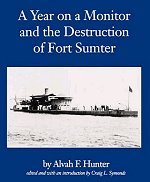
Year on a Monitor and the Destruction of Fort Sumter
Personal view of the Civil War Navy. The monitor saw action in several significant naval assaults by the Union's Squadron. It took part in the failed Federal attack on Sumter in April 1863. The "Nahant" also participated in the capture of the Confederate Ram "Atlanta," and in the assault on Fort Wagner
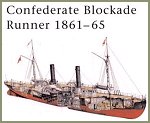
Confederate Blockade Runner 1861-65
The blockade runners of the Civil War usually began life as regular fast steam-powered merchant ships. They were adapted for the high-speed dashes through the Union blockade which closed off all the major Southern ports, and for much of the war they brought much-needed food, clothing and weaponry to the Confederacy
Kindle Available
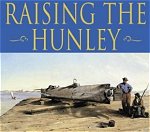
Raising the Hunley: The Remarkable History and Recovery of the Lost Confederate Submarine
During the Civil War, Union forces blockade the port of Charleston so the Confederate army seeks a way to attrack the Yankee Ships. George Dixon is part of the group of men given the task of creating and building the "fish boat," a submarine. The H.L. Hunley ultimately sets out on its mission to sink Yankee ships, but fails to return, its whereabouts unknown.
Kindle Available
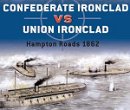
Confederate Ironclad vs Union Ironclad: Hampton Roads 1862
The Ironclad was a revolutionary weapon of war. Although iron was used for protection in the Far East during the 16th century, it was the 19th century and the American Civil War that heralded the first modern armored self-propelled warships.




